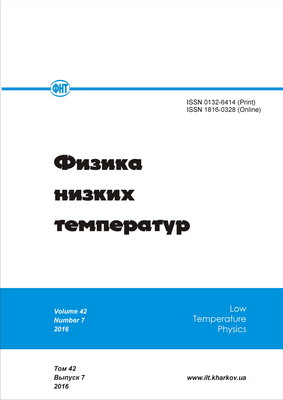
Бази даних
Наукова періодика України - результати пошуку
 |
Для швидкої роботи та реалізації всіх функціональних можливостей пошукової системи використовуйте браузер "Mozilla Firefox" |
|
|
Повнотекстовий пошук
| Знайдено в інших БД: | Реферативна база даних (5) |
Список видань за алфавітом назв: Авторський покажчик Покажчик назв публікацій  |
Пошуковий запит: (<.>A=Gordon E$<.>) | |||
|
Загальна кількість знайдених документів : 3 Представлено документи з 1 до 3 |
|||
| 1. | 
Gordon E. B. Realization of mechanical rotation in superfluid helium [Електронний ресурс] / E. B. Gordon, M. I. Kulish, A. V. Karabulin, V. I. Matyushenko, E. V. Dyatlova, A. S. Gordienko, M. E. Stepanov // Физика низких температур. - 2017. - Т. 43, № 9. - С. 1316-1323. - Режим доступу: http://nbuv.gov.ua/UJRN/PhNT_2017_43_9_6 The possibility of using miniaturized low-power electric motors submerged in superfluid helium for organization of rotation inside a cryostat has been investigated. It has been revealed that many of commercial micromotors can operate in liquid helium consuming low power. Turret with 5 sample holders, assembled on the base of stepper motor, has been successfully tested in experiments on the nanowire production in quantized vortices of superfluid helium. Application of the stepper motor made it possible in a single experiment to study the effect of various experimental parameters on the yield and quality of the nanowires. The promises for continuous fast rotation of the bath filled by superfluid helium by using high-speed brushless micromotor were outlined and tested. Being realized, this approach will open new possibility to study the guest particles interaction with the array of parallel linear vortices in He II. | ||
| 2. | 
Gordon E. B. Non-isothermal physical and chemical processes in superfluid helium [Електронний ресурс] / E. B. Gordon, M. I. Kulish, A. V. Karabulin, V. I. Matyushenko // Физика низких температур. - 2017. - Т. 43, № 9. - С. 1354-1362. - Режим доступу: http://nbuv.gov.ua/UJRN/PhNT_2017_43_9_11 Metal atoms and small clusters introduced into superfluid helium (He II) concentrate there in quantized vortices to form (by further coagulation) the thin nanowires. The nanowires' thickness and structure are well predicted by a double-staged mechanism. On the first stage the coagulation of cold particles in the vortex cores leads to melting of their fusion product, which acquires a spherical shape due to surface tension. Then (second stage) provided these particles reach a certain size they do not possess sufficient energy to melt and eventually coalesce into the nanowires. Nevertheless the assumption of melting for such refractory metal as tungsten, especially in He II, which possesses an extremely high thermal conductivity, induces natural skepticism. That is why we decided to register directly the visible thermal emission accompanying metals coagulation in He II. The brightness temperatures of this radiation for the tungsten, molybdenum, and platinum coagulation were found to be noticeably higher than even the metals' melting temperatures. The region of He II that contained suspended metal particles expanded with the velocity of 50 m/s, being close to the Landau velocity, but coagulation took place even more quickly, so that the whole process of nanowire growth is completed at distances about 1,5 mm from the place of metal injection into He II. High rate of coagulation of guest metal particles as well as huge local overheating are associated with them concentrating in quantized vortex cores. The same process should take place not only for metals but for any atoms, molecules and small clusters embedded into He II. | ||
| 3. | 
Gordon E. B. Experimental research of condensation processes occurring under laser ablation in superfluid helium and vacuum [Електронний ресурс] / E. B. Gordon, M. I. Kulish, M. E. Stepanov, V. I. Matyushenko, A. V. Karabulin // Фізика низьких температур. - 2020. - Т. 46, Вип. 9. - С. 1062-1067. - Режим доступу: http://nbuv.gov.ua/UJRN/PhNT_2020_46_9_5 Динаміку теплового випромінювання, що супроводжує конденсацію наночастинок вольфраму у надплинному гелії та вакуумі, експериментально досліджено у видимому діапазоні. Показано, що протягом перших 100 мкс теплова енергія, яка супроводжує процес у надплинному гелії, набагато перевищує відповідну енергію у вакуумі за порівнянних температур, після чого вона вирівнюється. Причинами цього є, по-перше, збільшення швидкості конденсації у надплинному гелії (через концентрацію наночастинок у квантованих вихорах) і, по-друге, більш висока ефективність нагрівання продуктів конденсації у надплинному гелії (через перевагу процесів із залученням частинок близьких розмірів). | ||
 |
| Відділ наукової організації електронних інформаційних ресурсів |
 Пам`ятка користувача Пам`ятка користувача |